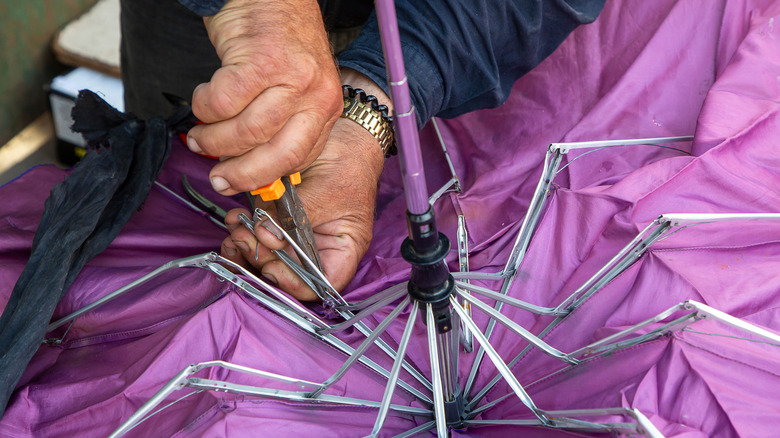The Clever Way You Can Use An Umbrella To Save Money On Laundry Day At Home
We may receive a commission on purchases made from links.
There's no denying the tumble dryer is an indispensable household tool. There's little chance of your clothes drying in the sticky heat of humid summer days. Likewise, you can't hang your clothing out if it's below freezing outside. However, there are seasons of the year when the humidity, sun, and wind combine to make air-drying an ideal option. You might even lower your energy bill a bit! Double the savings (and save trash from the landfill) by transforming a holey, worn umbrella into a free drying rack. The key to making this idea work lies in something you never want to happen when stuck in the rain on a windy day — you remove the canopy and turn the umbrella inside out.
Small umbrella frames, like those of rain umbrellas, work great indoors or out for drying socks and delicates, gym towels, or cleaning rags. A big old beach or patio umbrella makes the perfect clothesline for larger items — clothing aside; you might even be able to hang towels and bedsheets. Bonus: just like one of those pricey purpose-made racks (which, by the way, are even called "umbrella dryer racks"), you can fold the umbrella down for easy storage in a cupboard, garden shed, or under the stairs when not in use. At its simplest, all you really need to complete this DIY is a pair of sharp scissors. If you want to get fancy, splurge on a can of waterproof sealer or paint and some clothesline rope.
Source your supplies
First, assess your umbrella to ensure it's suitable for this DIY project. If your umbrella has a lot of rust on the metal, it will likely not work. Unpainted, the rust will stain your textiles; if you paint the frame, the rust will continue to eat into the metal, weakening the spokes. Reconsider using an umbrella missing the protectors on the end of the spokes — sharp, pointy arms hanging at eye level aren't a good idea. Also, if the umbrella no longer closes, you won't be able to store it easily, though this isn't a problem if you plan to hang it permanently somewhere.
If you plan to go the easy route (that is, remove the canopy and use the umbrella right away), all you'll need for a rain umbrella is a pair of scissors and a seam ripper. The canopies on patio umbrellas are typically designed to be removable, so you won't need any tools to take one off. If the metal on your umbrella has seen better days or you want to weatherproof it, get a can of waterproofing paint for stainless steel. We like Rust-Oleum Professional gloss stainless steel spray paint — $9.98 for a 14-ounce can from Lowe's. Want to go all out and add clothesline rope to your umbrella? You'll need a roll of weatherproof clothesline rope — get 50 feet of Smart Design all-purpose clothesline for $7.99 on Amazon — and a drill and drill bit slightly wider than the width of the rope.
The how-to
Remove the canopy from the umbrella. For rain umbrellas, that means picking the stitching at the end of each arm using a seam ripper. Next, cut the canopy from the umbrella handle using your scissors. Gently pull out any leftover fabric. For patio umbrellas, consult the manufacturer's instructions on removal. Turn the frame inside out and use it just as it is, or weatherproof the metal with stainless steel spray paint, leaving the rack to cure for the time instructed on the can before using it — usually between 36 and 48 hours. If you wish to string your new drying rack with clothesline rope, drill holes in each arm at repeated intervals, starting about 5 inches from the end. Thread rope through the holes, cutting and tying it off securely after each row.
Smaller DIY umbrella drying racks work best indoors. Hang them in your laundry room, living room, kitchen, or sunroom to take advantage of the heat from your dryer, fireplace, or stove for drying small items, especially in the winter. Take a folding rack with you on vacation — they're great in hotel rooms or when camping. Outdoors: hang the frame from your clothesline, under your patio, in a covered balcony. If you have the stand from your patio umbrella, reuse that. Clothespins aren't necessary indoors but might be helpful when drying outdoors on windy days. Once your new-to-you rack is up, all that's left is to familiarize yourself with some pro tips for air-drying your laundry!

